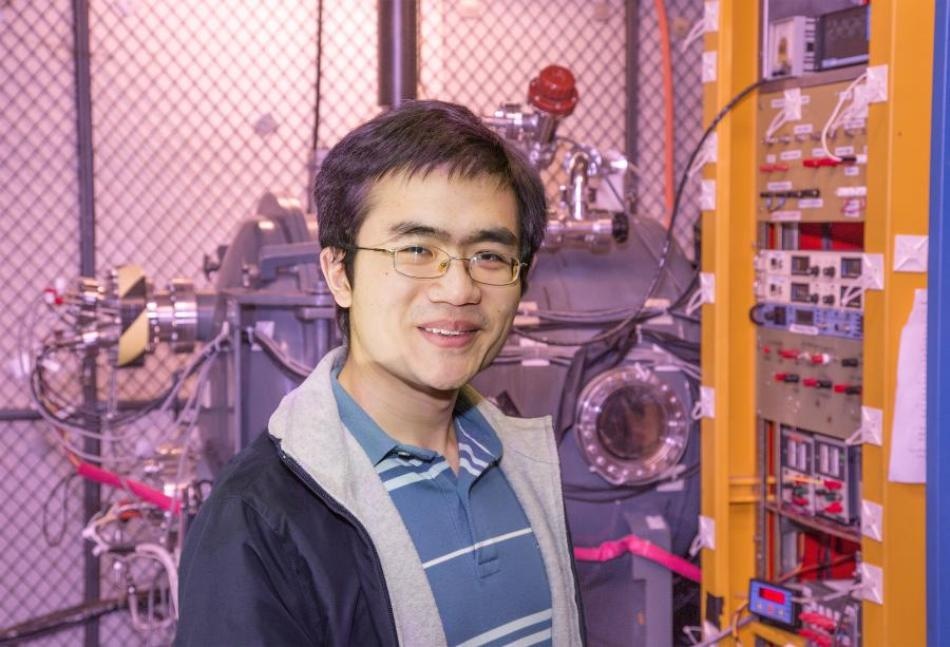Aug 1 2016
A few interesting issues in plasma physics revolve around X-ray pulsars, which are collapsed stars orbiting a cosmic companion and beam light at regular intervals, similar to lighthouses in the sky.
 Graduate student Yuan Shi. CREDIT: (Photo by Elle Starkman/Office of Communications)
Graduate student Yuan Shi. CREDIT: (Photo by Elle Starkman/Office of Communications)
Physicists focus on analyzing the magnetic field’s strength and density of the plasma surrounding these pulsars, which are capable of being millions of times greater than plasma’s density in stars like the sun.
A new theory of plasma waves that has the potential to infer these properties in a detailed manner unlike the other conventional approaches has been developed by researchers at the U.S. Department of Energy’s (DOE) Princeton Plasma Physics Laboratory (PPPL).
The new study examines the plasma adjacent to the pulsar by linking Einstein’s theory of relativity together with quantum mechanics, which explains the motion of subatomic particles such as the atomic nuclei or ions and electrons present in plasma. This research is supported by the DOE Office of Science.
Quantum field theory
The main insight is obtained from quantum field theory, which explains charged particles that are relativistic, highlighting the fact that their travelling time is almost close to the speed of light. “Quantum theory can describe certain details of the propagation of waves in plasma,” said Yuan Shi, a graduate student in the Princeton Program in Plasma Physics and key author of a paper published July 29 in the journal Physical Review A.
The plasma’s composition can then be revealed by learning the interactions behind the propagation.
The paper was developed by Shi along with assistance from co-authors Nat Fisch, director of the Program in Plasma Physics and professor and associate chair of astrophysical sciences at Princeton University, and Hong Qin, a physicist at PPPL and executive dean of the School of Nuclear Science and Technology at the University of Science and Technology of China. “When I worked out the mathematics they showed me how to apply it,” said Shi.
The magnetosphere is the magnetized atmosphere surrounding the body. In pulsars, relativistic particles in the magnetosphere absorb light waves, and this absorption exhibits peaks against a blackbody background.
“The question is, what do these peaks mean?” asks Shi. Shi stated that the field strength and density of the magnetosphere can be determined based on the analysis of the peaks with equations obtained from specific relativity and quantum field theory.
Combining physics techniques
The procedure integrates the techniques of plasma physics, condensed matter physics, and high-energy physics. Model equations are used in plasma physics to illustrate the collective movement of millions of particles.
Quantum mechanics is used in condensed matter physics to explain the states of a wide range of particles. In high-energy physics, quantum field theory is used by researchers to explain the interaction of a handful of particles. Aspects from all these techniques are used by the new technique to examine the plasma waves in pulsars.
The same method can be used to understand the plasma’s density and the magnetic field’s strength that is developed by inertial confinement fusion experiments.
These experiments use lasers to vaporize or ablate a target containing plasma fuel. The ablation causes an implosion that results in compressing the fuel into plasma and developing fusion reactions.
Standard formulas give inconsistent answers
Researchers aim at analyzing the precise field strength, temperature and density of the plasma that this technique develops.
Conventional mathematical formulas provide inconsistent answers when lasers of varied colors are used to measure the plasma parameters. This is because the intense density of the magnetic field creates relativistic effects, says Shi.
The results can thus be reconciled with the help of formulations that draw upon both fields.
For Shi, the new technique highlights the advantages of integrating physics disciplines that do not often interact. Says he: “Putting fields together gives tremendous power to explain things that we couldn’t understand before.”
PPPL, on Princeton University's Forrestal Campus in Plainsboro, N.J., is focused on developing new knowledge about the physics of plasmas, ultra-hot, charged gases, and creating practical solutions for production of fusion energy.
Results of PPPL research range from a portable nuclear materials detector for anti-terrorist use to globally used computer codes for examining and predicting the outcome of fusion experiments. The University for the U.S. Department of Energy’s Office of Science that manages the Laboratory is the largest single supporter of basic research in the field of physical sciences in the United States, and is also working towards addressing few of the most critical and existing challenges.